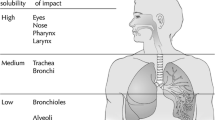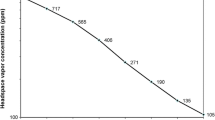Abstract
Activation of the trigeminal nerve endings in eyes and nose, termed sensory irritation, was determined from the reflexively induced decrease in respiratory rate in mice for methyl propyl ketone, methyl butyl ketone, methyl amyl ketone and methyl hexyl ketone. The relationship between exposure concentration and the decrease in respiratory rate followed Michaelis-Menten equations. Two estimates of each agonist-receptor dissociation constant were obtained, one from the Michaelis-Menten equation and one from the threshold (RD-0) of the log concentration-effect curve. The values were equal and thus one receptor type could account for the activation process. The hydrophobic properties of the receptor biophase were found to approach that of the internal part of the bilayer membrane. It therefore follows that the receptor-air partition coefficients increase with the size of the ketones, thus accounting for the observed increase in potency. Estimates of Threshold Limit Values (TLV) were obtained and compared with established values. Close agreements were found for methyl propyl ketone and methyl amyl ketone, but not for methyl butyl ketone, where the neurotoxic effect constituted a more sensitive endpoint that sensory irritation.
Similar content being viewed by others
References
Abraham MH, Whiting GS, Alarie Y, Morris JJ, Taylor PJ, Doherty RM, Taft RW, Nielsen GD (1990) Hydrogen bonding 12. A new QSAR for upper respiratory tract irritation by airborne chemicals in mice. Quant Struct-Act Relat 9: 6–10
ACGIH (1991) Threshold limit values and biological exposure indices for 1991–1992. American Conference of Governmental Industrial Hygienists, Cincinnati
Alarie Y (1973) Sensory irritation by airborne chemicals. CRC Crit Rev Toxicol 2: 299–363
Alarie Y (1981a) Dose-response analysis in animal studies; prediction of human responses. Environ Health Perspect 42: 9–13.
Alarie Y (1981b) Toxicological evaluation of airborne chemical irritants and allergens using respiratory reflex reactions. In: Leong BKJ (ed) Proceedings of the inhalation toxicology and technology symposium. Ann Arbor Science Publishers, Collingwood, pp 207–231
ASTM (1984) Standard test method for estimating sensory irritancy of airborne chemicals. American Society for Testing and Materials. Philadelphia, designation: E981–84
Ceaurriz J de, Micillino JC, Bonnet P, Guenier JP (1981) Sensory irritation caused by various industrial airborne chemicals. Toxicol Lett 9: 137–143
Ceaurriz J de, Micillino JC, Marignac B, Bonnet P, Muller J, Guenier JP (1984) Quantitative evaluation of sensory irritating and neurobehavioural properties of aliphatic ketones in mice. Food Chem Toxicol 22: 545–549
Colquhoun D (1971) Lectures on biostatistics. Clarendon Press, Oxford
Douglas RB (1974) Human reflex bronchoconstriction as an adjunct to conjunctival sensitivity in defining the threshold limit values of irritant gases and vapours. Thesis, TUC Centenary Institute of Occupational Health London School of Hygiene and Tropical Medicine, University of London
Franke R (1984) Theoretical drug design methods. Elsevier, Amsterdam
Glogowska M, Richardson PS, Widdicombe JG, Winning AJ (1972) The role of the vagus nerves, peripheral chemoreceptors and other afferent pathways in the genesis of augmented breaths in cats and rabbits. Respir Physiol 16: 179–196
Hald A (1960) Statistical theory with engineering applications. John Wiley & Sons Inc, New York
Hansch C, Leo A (1979) Substituent constants for, correlation analysis in chemistry and biology. John Wiley, New York
Hansen LF, Knudsen A, Nielsen GD (1992) Sensory irritation effects of methyl ethyl ketone and its receptor activation mechanism. Pharmacol Toxicol 71: 201–280
Hine J, Mookerjee PK (1975) The intrinsic hydrophilic character of organic compounds. Correlations in terms of structural contributions. J Org Chem 40: 292–298
Jammes Y (1988) Tonic sensory pathways of the respiratory system. Eur Respir J 1: 176–183
Kane LE, Dombroske R, Alarie Y (1980) Evaluation of sensory irritation from some common industrial solvents. Am Ind Hyg Assoc J 41: 451–455
Kenakin TP (1987) Pharmacologic analysis of drug-receptor interaction. Raven Press, New York
Krasavage WJ, O’Donoghue JL, Divincenzo GD (1982) Ketones. In: Clayton GD, Clayton FE (eds) Patty’s industrial hygiene and toxicology, vol. 2c, 3rd edn. John Wiley & Sons, New York, pp 4709–4800
Kristiansen U, Nielsen GD (1988) Activation of the sensory irritant receptor by C7–C11 n-alkanes. Arch Toxicol 61: 419–425
Kristiansen U, Hansen L, Nielsen GD, Holst E (1986) Sensory irritation and pulmonary irritation of cumene and n-propanol; mechanisms of receptor activation and desensitization. Acta Pharmacol Toxicol 59: 60–72
Kristiansen U, Hansen LF, Nielsen GD (1989) Determination of vapors of cumene-propanol mixtures by single-beam infrared spectrophotometry. Appl Ind Hyg 4: 171–174
Leatherbarrow RJ (1987) Enzfitter. Elsevier, Amsterdam
Muller J, Greff G (1984) Recherche de relations entre toxicite de molecules d’interet industriel et proprietes physico-chemiques: test d’irritation des voies aeriennes superieures applique a quatre familles chimiques. Food Chem Toxicol 22: 661–664
Nielsen GD (1991) Mechanisms of activation of the sensory irritant receptor by airborne chemicals. CRC Crit Rev Toxicol 21: 183–208
Nielsen GD, Alarie Y (1982) Sensory irritation, pulmonary irritation, and respiratory stimulation by airborne benzene and alkylbenzenes: prediction of safe industrial exposure levels and correlation with their thermodynamic properties. Toxicol Appl Pharmacol 65: 459–477
Nielsen GD, Bakbo JC (1985a) Exposure limits for irritants. Ann Am Conf Ind Hyg 12: 119–135
Nielsen GD, Bakbo JC (1985b). Sensory irritating effects of allyl halides and a role for hydrogen bonding as a likely feature at the receptor site. Acta Pharmacol Toxicol 57: 106–116
Nielsen GD, Yamagiwa M (1989) Structure-activity relationships of airway irritating aliphatic amines. Receptor activation mechanisms and predicted industrial exposure limits. Chem Biol Interact 71: 223–244
Nielsen GD, Olsen J, Bakbo JC, Holst E (1985) Propyl ether. II. Pulmonary irritation and anaesthesia. Acta Pharmacol Toxicol 56: 165–175
Nielsen GD, Thomsen ES, Alarie Y (1990) Sensory irritant receptor compartment properties. Acta Pharm Nord 1: 31–44
Nielsen GD, Hansen LF, Alarie Y (1992) Irritation of the upper airways. Mechanisms and structure-activity relationships. In: Knöppel H., Wolkoff P (eds) Chemical, microbiological, health and comfort aspects of indoor air quality state of the art in SBS. Kluwer Academic Publishers. Dordrecht, pp. 99–114
O’Flaherty EJ (1981) Toxicants and drugs. Kinetics and dynamics. John Wiley & Sons, New York
Roberts DW (1986) QSAR for upper-respiratory tract irritation. Chem Biol Interact 57: 325–345
Schaper M (1993) Development of a database for sensory irritants and its use in establishing occupational exposure limits. Am Ind Hyg Assoc J 54: 488–544
Schrenk HH, Yant WP, Patty FA (1936) Acute response of guinea pigs to vapors of some new commercial organic compounds. X. Hexanone. US Public Health Rep 51: 624–631
Silver WL, Mason JR, Adams MA, Smeraski CA (1986) Nasal trigeminal chemoreception: Responses to n-aliphatic alcohols. Brain Res 376: 221–229
Smyth HF, Carpenter CP, Weil CS, Pozzani UC (1954) Range-finding toxicity data: list V. Arch Ind Hyg Occup Med 10: 61–68
Smyth HF, Carpenter CP, Weil CS, Pozzani UC, Striegel JA (1962) range-finding toxicity data: List VI. Am Ind Hyg Assoc J 23: 95–107
Specht H, Miller JW, Valaer PJ, Sayers RR (1940) Acute response of guinea pigs to the inhalation of ketone vapors. National Inst. of Health Bulletin 176: 1–66
Widdicombe J (1986a) The neural reflexes in the airways. Eur J Respir Dis 68 [Suppl 144]: 1–33
Widdicombe J (1986b) Sensory innervation of the lungs and airways. Prog Brain Res 67: 49–64
Yant WP, Patty FA, Schrenk HH (1936) Acute response of guinea pigs to vapors of some new commercial organic compounds. IX. Pentanone. US Public Health Rep 51: 392–399
Author information
Authors and Affiliations
Rights and permissions
About this article
Cite this article
Hansen, L.F., Nielsen, G.D. Sensory irritation and pulmonary irritation of n-methyl ketones: receptor activation mechanisms and relationships with threshold limit values. Arch Toxicol 68, 193–202 (1994). https://doi.org/10.1007/s002040050054
Received:
Accepted:
Issue Date:
DOI: https://doi.org/10.1007/s002040050054




